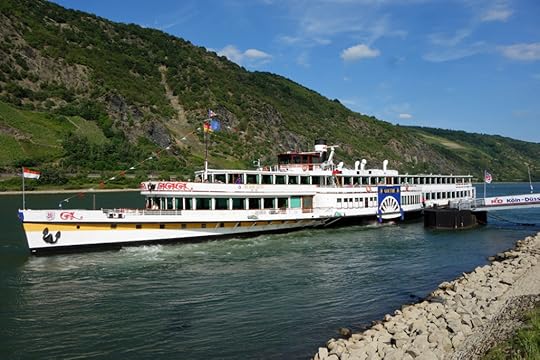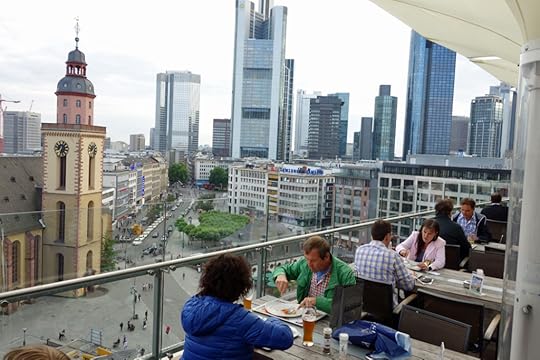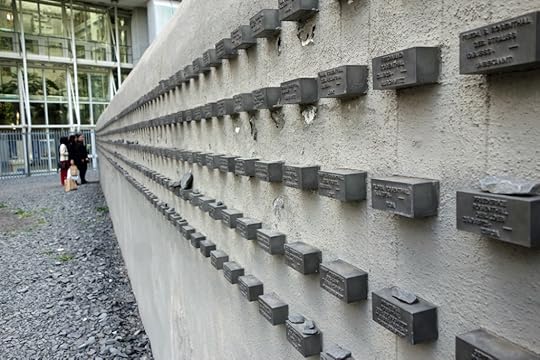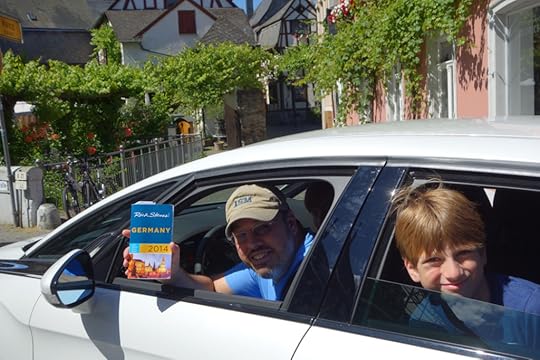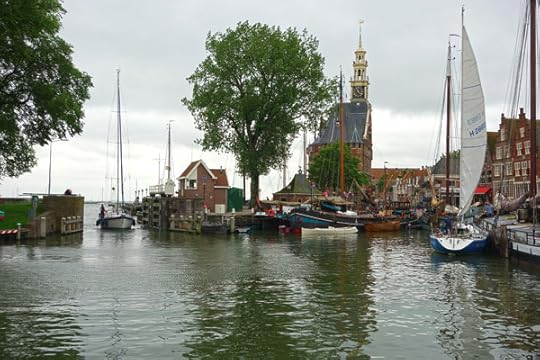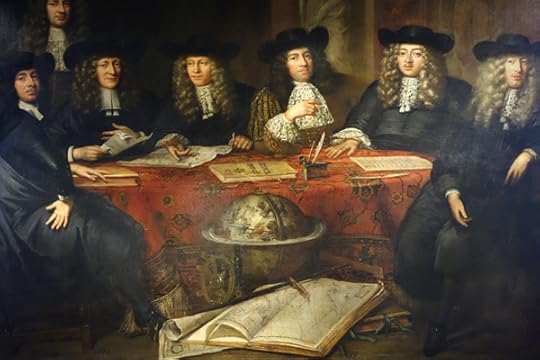Rick Steves's Blog, page 56
July 8, 2014
Visiting the Rhine River Valley
Visiting the Rhine River Valley never gets old. It’s storybook Germany, a fairy-tale world of legends and robber-baron castles. For a quick visit, I’d cruise the most castle-studded stretch of the romantic Rhine, from Koblenz to Bacharach. For hands-on thrills, climb through the Rhineland’s greatest castle, Rheinfels, above the town of St. Goar. Castle connoisseurs will also enjoy Marksburg, with the best castle interior on the Rhine. I spend my Rhine nights in the castle-crowned village of Bacharach.
While the Rhine River is lined by scenic roads, train tracks, and bike lanes, the most relaxing way to enjoy the Rhine is by romantic old steamers.
 The first time I slept along the Rhine, it was in one of Europe’s great youth hostels: Stahleck Castle. Imagine spending just $30 a night for your bed with breakfast, and ending your day with a drink on your own Rhine-view balcony like this. I just dropped in again as I was updating my guidebook, and the castle-hostel is a dreamy as ever. I hiked up here with Thomas, a friend from the village below, who recalled how, back in the ‘70s, he and his friends literally scaled the castle walls as kids to hang out with the British and American girls staying in the hostel.
The first time I slept along the Rhine, it was in one of Europe’s great youth hostels: Stahleck Castle. Imagine spending just $30 a night for your bed with breakfast, and ending your day with a drink on your own Rhine-view balcony like this. I just dropped in again as I was updating my guidebook, and the castle-hostel is a dreamy as ever. I hiked up here with Thomas, a friend from the village below, who recalled how, back in the ‘70s, he and his friends literally scaled the castle walls as kids to hang out with the British and American girls staying in the hostel.
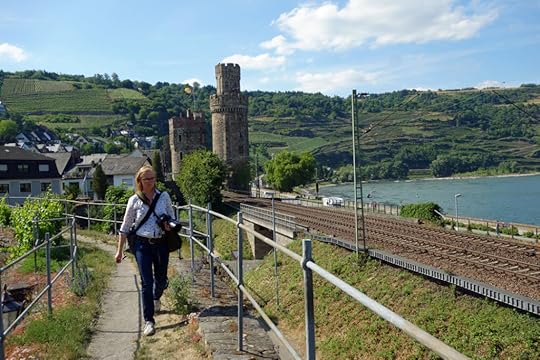 While I’ve always loved Rheinfels Castle in St. Goar, and the town of Bacharach, the town of Oberwesel (midway between St. Goar and Bacharach) has long intrigued me. So on this trip, I visited Oberwesel, and I was charmed enough to write it up as a worthwhile stop. Just four miles from Bacharach, it’s a worth a quick visit to see its charming main square, walk along its fun surviving medieval wall, and explore the best collection of historic Rhine artifacts I found within the romantic Rhine gorge.
While I’ve always loved Rheinfels Castle in St. Goar, and the town of Bacharach, the town of Oberwesel (midway between St. Goar and Bacharach) has long intrigued me. So on this trip, I visited Oberwesel, and I was charmed enough to write it up as a worthwhile stop. Just four miles from Bacharach, it’s a worth a quick visit to see its charming main square, walk along its fun surviving medieval wall, and explore the best collection of historic Rhine artifacts I found within the romantic Rhine gorge.
 Climbing along the upper wall of the town of Oberwesel, I found a path that leads through a peaceful little meadow and forest with great wall and town views. The Cowherd’s Tower is now a private home with a fanciful drawbridge. In local folklore, the current family’s teenage son threw a rowdy graduation party in the tower. With all the noise, neighbors complained. When the police came, the kids just hoisted up the drawbridge and partied on.
Climbing along the upper wall of the town of Oberwesel, I found a path that leads through a peaceful little meadow and forest with great wall and town views. The Cowherd’s Tower is now a private home with a fanciful drawbridge. In local folklore, the current family’s teenage son threw a rowdy graduation party in the tower. With all the noise, neighbors complained. When the police came, the kids just hoisted up the drawbridge and partied on.
July 7, 2014
The Rhine: Steamy with Romance
After 30 years of cruising the romantic Rhine gorge on nostalgic old riverboats, I still get a thrill. Imagine riding this majestic old steamboat from village to village, visiting ruined castles and enjoying the local hospitality.
July 3, 2014
Frankfurt: Junkies and Brothels
Frankfurt has long been Germany’s trade center. And with trade comes prostitution and drugs. The city takes a pragmatic, compassionate, and seemingly effective “harm reduction” approach to both of these challenges.

This painting is a thought-provoking reminder that the phenomenon of wealthy old men setting their sights on younger women is nothing new…especially in a trading center like Frankfurt. Ever since the Middle Ages, Frankfurt’s thriving prostitution industry has gone hand-in-hand with its trade fairs. Today, prostitution thrives with the convention center. Like hotels, prostitutes double their prices during big trade fairs. Sex workers note that business varies with the theme of the trade show: While the auto show is boom time, and the butchers’ convention is famously hungry, they complain that Frankfurt’s massive book fair is a bust.
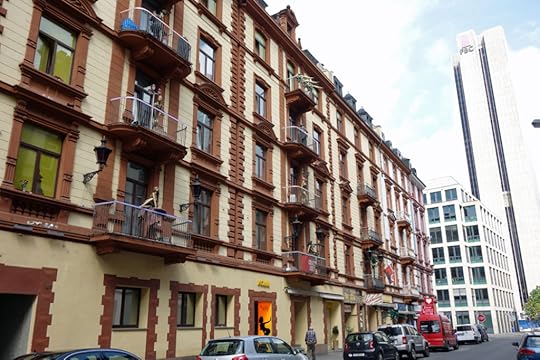
Prostitution is big business here, and perfectly legal since 2002. German sex workers get health care just like any other workers, and pay taxes (on an estimated €14 billion of declared income each year). As I marveled the poignant sight of high-rise banks and office buildings towering above Frankfurt’s brothels, my guide said, “Prostitutes, who pay about €130 a day to rent their rooms, cover their rent by the end of the businessmen’s lunch break.”
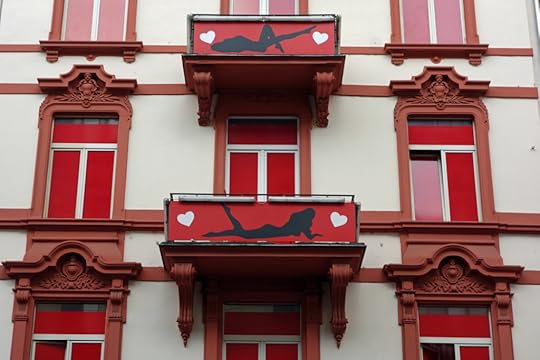
A couple of blocks in front of Frankfurt’s train station, you’ll find a row of high-rise brothels, or “eros towers.” With all the businessmen coming into town, there’s no way to outlaw prostitution. So the city has decided to contain and control prostitution into what it calls a “tolerance area.” Within about a block of here are about 20 of these five-story brothels in original late-19th-century apartment flats — each filled with prostitutes. The sex workers, who are mostly from Eastern Europe, Latin America, and Thailand (and only about 2 percent German), charge around €20. These women rent their rooms and essentially run their own little businesses. Crazy Sexy is biggest of these brothels, with 180 rooms (51 Elbestrasse). The first three floors are female sex workers, while transvestites occupy the fourth floor. (My guide said, “Gender reassignment surgery is expensive, and many of these people are saving up for their operation.”)

Walking the streets of Frankfurt, you may see a gang of junkies congregating at a government-funded heroin maintenance clinic (also known as a “Café Fix”). In the 1980s, Frankfurt was plagued by one of the largest open drug scenes in Europe. Its parks (and police) were overwhelmed with needle addicts. Then Frankfurt decided to get creative, take the crime out of the equation, and go for pragmatic harm reduction. In 1992, Frankfurt began offering “pump rooms” to its hard-drug users. The idea: provide a safe haven for addicts (mostly heroin, but also crack and methadone) to hygienically maintain their habit. Heroin addicts would still buy their stuff on the street, but inject here with clean needles, medical help standing by, and a place to stay if needed. It’s strictly not for first-time users, and no dealing or sharing of drugs is allowed. These centers provide a safe and caring place for addicts — who are considered not criminals, but sick people — to maintain their habit and get counseling and medical help. Two decades later, overdose deaths are down 75 percent, and there’s never been a death in a “drug consumption room.” Locals consider the program a success and are accustomed to seeing groups of junkies hanging out in front of these places. While unsightly, the compassionate “harm reduction” approach much of Europe uses to deal with this problem saves lives. Meanwhile, the USA continues to suffer double the heroin-related deaths as Europe (despite Europe’s much larger population).
July 2, 2014
Frankfurt: Skyscraper Views, Powerful Memorials, and a Tasty Sandwich
Frankfurt, while low on Old World charm, offers a good look at today’s no-nonsense, modern Germany. Ever since the early Middle Ages when, as its name hints, Frankfurt was a good place to ford (-furt) the river, people have gathered here to trade. A pragmatic city, Frankfurt’s decisions are famously based on what’s good for business. Destroyed in WWII? Take it as an opportunity to rebuild better than ever for trade. And that’s what they did.
Cosmopolitan Frankfurt — nicknamed “Bankfurt” — is a leading business center and home to the European Central Bank. Though it’s often avoided by tourists (who consider it just a sterile transportation hub), Frankfurt’s modern energy, fueled in part by the entrepreneurial spirit of its immigrant communities, makes it a unique and entertaining city that’s well worth a look.
Finished in 2000, the Main Tower offers the best (and only public) viewpoint from the top of a Frankfurt skyscraper. For €6.50 (about $9), you can enjoy a 55-second, ear-popping elevator ride to the 54th floor, 650 feet above the city. Frankfurt is bursting with striking architecture. By German law, no worker should be kept out of natural light for more than four hours, so work environments are filled with light. And, as you can see, Germans like their skyscrapers with windows that open.
For a cheaper — but still grand — city view, nurse a drink on the rooftop of the Galeria Kaufhof department store. All over Europe, towering department stores offer great cafeteria lunches…with rooftop views for no extra charge.
Anywhere in Europe, the market halls come with great eateries, priced for local shoppers and serving the freshest of quality ingredients. And when the locals are lining up, you know something exciting is being served up — like the best sausage sandwiches around, here in Frankfurt’s wonderful Kleinmarkthalle. This delightful, old-school market was saved from developers by local outcry, and to this day it’s a neighborhood favorite. Browse and sample your way through the ground floor. It’s an adventure in fine eating and a photographer’s delight.
All over Europe, WWI and WWII war memorials are located prominently, for all to remember…except in Germany, where citizens walk a fine line of honoring lost loved ones without celebrating their cause. This memorial, tucked away in a Frankfurt park, is very easy to miss. While other countries honor those lost “for God and country,” German casualties are “victims of violence.” On one memorial reads, “Germany brought the war to the world, and the war came back to Germany.”
The memorial to Frankfurt’s Jewish community, which was devastated by the Holocaust, is at the site of the old Jewish ghetto, where the city’s main synagogue once stood. Commemorating 12,000 murdered Jews, it’s a powerful and evocative collection of images: Around the cemetery is the Wall of Names, with a tiny tombstone for each Frankfurt Jew deported and murdered. This gives each victim the dignity of being named (a data bank inside the adjacent museum keeps their memory alive with everything known about each person). The pebbles atop each tomb represent Jewish prayers. A paved section in front of this marks the footprint of the Börneplatz Synagogue, which was destroyed on November 9, 1938. While this night is often called Kristallnacht (“Crystal Night”), recently historians have pointed out that real people were destroyed along with lots of glass, so the preferred name is now “Pogrom Night.” In the wake of WWII, American troops made Frankfurters memorialize each synagogue they destroyed with a plaque.
July 1, 2014
Join me for two months of summer travels north of the Alps
If you know me, you know I’m in a rut. I spend four months a year working in Europe: spring in the Mediterranean, go home for a short break in June, and then July and August north of the Alps. I’ve just enjoyed a short break back in Seattle. (I’ve heard it’s nice there in the summer.) Now I’m back in Europe and excited to be kicking off my summer travels. I’m also excited to be packing you along.
I’ll be blogging daily for the next 60 days following this itinerary: guidebook research in Germany (Frankfurt, Rhine, Würzburg, Nürnberg, Dresden), filming two new TV shows in the Netherlands (one in Amsterdam and one in the countryside), guidebook research in Scandinavia (Norway, Sweden, Denmark), film TV shows in Berlin and Prague, and finally eight days in Poland.
On my first day in Germany I met people like this family, who are basing their trips on my guidebooks. These are the people I am working for. And seeing how much fun they’re having–and to think that I’m a small part of that travel joy–makes my work very gratifying. It stokes my battery.
I see we’re about to break 200,000 friends on my Facebook page. I’m scheming up something fun to celebrate…but I need a few more travel buddies. If you have any friends who like to travel, invite them to “like” me and join me for this next two months of European travel. I promise it’ll be a great trip.
June 30, 2014
Launching winter 2015 dates for 10 great European tour itineraries
For 30 years we’ve led our tours of Europe through “the season”–roughly April through October. And now, by popular demand from the many people who want cheaper airfares and the peace of off-season travel, we are ready to give “winterize” a whole new and happy meaning.
We’ve just launched our winter 2015 dates for 10 great itineraries. Why just 10? Not every destination is a good fit for February-March travel, but the ones we’ve chosen really transcend the seasons: Barcelona-Madrid, London, Paris, Rome, Venice-Florence-Rome, Heart of Italy, Sicily, Greece, Istanbul, and Turkey. For a smart traveler, when it comes to these exciting destinations, “winter” is a great idea.
Some of my warmest European memories have been in the off-season. We’d like to help you enjoy the same experiences this next February or March!
June 28, 2014
Food Police, My Evil Twin, and a Culinary Faux Pas
Thanks for all your thoughtful replies to the video clip about the cobbler in Orvieto and the plight of artisans in our modern world. The video was produced by Steven Brenner, and receiving it from him reminded me of a different, yet equally creative, effort from Steve.
This little clip shows how my evil twin tried to get away with putting Parmesan cheese on spaghetti with clams. Fortunately, he was scuttled by three little members of Rome’s heroic food police.
Watch more of the Food Police’s adventures at foodpolice.it and learn more about the producers at cross-pollinate.com and orvietoorbust.com.
June 27, 2014
Can We Save Artisan Europe?
Recently I was visiting with the last man in Rothenburg, Germany, to make etchings in the style of Albrecht Dürer. He’s in failing health and in about a year, his 3,000 lovingly etched copper plates will be retired and parked in some obscure museum’s basement. Friends in little towns on the Rhine are lamenting how the younger generation is not following in the footsteps of their family businesses and, as they flee to the energy of the big cities, their parents’ businesses just fade away. The artists who craft handmade guitars in Madrid, the family winemakers of Burgundy, the fisherman who sells his shrimp on the Oslo harborfront–these have all been fixtures of Europe for me in a lifetime of travels. What will become of all these rich facets of local culture when the younger generation opts out? Of course, I can’t blame the children of the artisans for jumping into the modern rat race any more than I’m guilty for not being an old-school piano technician like my dad. But it is worth considering how the future will look when economic scale and efficiency trumps artisan values.
My friend, Steven Brenner (who runs Cross-Pollinate, with some of my favorite budget beds in Rome and beyond) produced a little video that eloquently says what I’ve been thinking lately about artisans in Europe. Check out this short video featuring a young cobbler in Orvieto, Italy, who, in the simple words of a traditional, small-town artisan, captures perfectly an art form we are all losing.
What are your favorite experiences that celebrate the artisan way of life in Europe?
June 25, 2014
Amsterdam’s Tram Corridor is a Boon to Sightseers
When covering Europe, I enjoy raising awareness of public transportation routes that fit the needs of travelers. In Amsterdam there’s a sightseeing spine right through the city center that goes past the Rijksmuseum and this “I amsterdam” sign. Conveniently, this spine is a tram corridor: Trams #1, #2, and #5 come by every two minutes. Taking advantage of this route empowers any visitor. Here’s a new sidebar I wrote for the next edition of our Rick Steves Amsterdam guidebook about this transit spine:
Amsterdam’s Spine by Tram
Tram #1, #2, or #5 from Central Station to Leidseplein (and Museums)
Amsterdam becomes much easier to get your brain around when you master the tram #1, #2, and #5 corridor. As if made for the sightseer, this main tram thoroughfare makes connecting the main train station, the Jordaan neighborhood, my recommended hotels, and the museum zone amazingly easy. The entire ride takes about 20 minutes, with trams zipping by about every two minutes. Use this route for an overview and to lace together major sightseeing spots in the city. At any point you can simply hop off, cross the street, and catch a tram heading back exactly where you came from. A single €2.80 ticket is good for an hour–or you can get the all day or multi-day passes (all sold on the tram). Starting at Amsterdam’s Central Station, here are the stops (and what you need to know about each):
Centraal Station
This is the first and last stop. All #1, #2, and #5 trams starting here are heading in the correct direction. Nearby: The free ferry across the IJ, the starting point for the Rick Steves Audio Europe Amsterdam City Walking Tour, a transportation hub (airport shuttle, bus station, trains, many other trams, subway), bike rentals, the Red Light District, and the start of Damrak (the city’s main drag).
Martelaarsgracht
Notice how the street is wide: Wide streets are generally former canals filled in. (Hint: “gracht” means canal.) Nearby: The Haarlemmerstraat shopping district.
Nieuwezijds Kolk
(nothing of interest nearby)
Dam
You’ll roll by the back side of the towering New Church and Royal Palace on the left. Nearby: Dam Square, Anne Frank House, and the starting point for two Rick Steves Audio Europe tours: Jordaan and Red Light District.
Spui
Pronounced “shpou” (rhymes with cow)–which meant “spew”–this square is where water was once pushed away over a dike. Nearby: Amsterdam History Museum, Begijnhof, University District, bookstores, and the Nine Streets (elegant shopping zone).
Koningsplein
From Spui, the tram turns right. Over the next few stops it crosses four canals: Singel, Heren, Keizers, and Prinsen. Remember the memory aid: “A Single Hairy Kaiser’s Prince really knows his canals.” Nearby: Mint Tower and the flower market.
Keizersgracht
Here the street fills with people and gets so narrow that trams share one set of rails, and bikers are required to walk their bikes. Nearby: The vibrant shopping district of modern Amsterdam.
Prinsengracht
You’ll roll past more shops and more pedestrians.
Leidseplein
This is the tourists’ nightlife center with the famous Bulldog Café and Coffeeshop (a former police station that now sells pot). You’ll find venerable, edgy nightclubs and concert venues like the Melkweg and Paradiso, plus the city theater (Stadsschouwburg). From here, trams #2 and #5 leave the old town, cross the outermost canal, pass an entry to Vondelpark, and head for the Rijksmuseum. (If you’re on tram #1, hop out at Leidseplein.)
Rijksmuseum (tram #2 and #5 only)
This is the start of the museum zone with a popular park (with a pond and much photographed “I amsterdam” sign) and several great museums. Nearby: Rijksmuseum, House of Bols Cocktail & Genever Experience, and Costers Diamonds (diamond cutting and polishing).
Van Baerlestraat (tram #2 and #5 only)
Jump out here for the Van Gogh Museum or the Stedelijk Museum.
Jacob Obrechtstraat (tram #2 only)
Here you leave the commotion of the city–and its tourists–and are in a district of high-end apartments. The inviting Café Gruter faces the tram stop. Nearby: The entry to Vondelpark (with the recommended Blue Tea House).
June 24, 2014
Traveling in the Netherlands Beyond Amsterdam
Traveling around the Netherlands, I found a number of delightful towns with historic centers that evoke the days of Henry Hudson. Delft, Haarlem, Leiden, and Hoorn were my favorites. The vast majority of visitors to the Netherlands see only Amsterdam. While these other towns are all variations on the same theme, the small historic Dutch cities outside of Amsterdam are important to consider–and all are well within an hour by train.
Hoorn has a salty allure, even though the salt is gone now that the Zuiderzee has been dammed and turned into a big freshwater lake. Still, Hoorn’s harbor evokes a time when Dutch vessels dominated much of the seagoing economy.
The Dutch Golden Age, the 16th and 17th centuries, was a time when people went to apparently ridiculous lengths to show off their wealth. What was a simple collar became not just a ruff, but a super-duper ruff. This woman’s husband must have been a very successful merchant.
Seeing these Dutch masters plotting with their globe and their greedy aspirations, I found myself singing, “We are the world…”
The Dutch enjoy getting drunk on their vacation boats. And just as you can’t drink and drive a car, in the Netherlands you can’t drink and sail a boat. The Dutch police enjoy zooming in on their police jet skis to crash the party. I’m sure just the presence of this trailer with a pair of these zippy machines served as a sobering reminder to yachters enjoying a break in the Hoorn harbor.
Rick Steves's Blog
- Rick Steves's profile
- 673 followers


